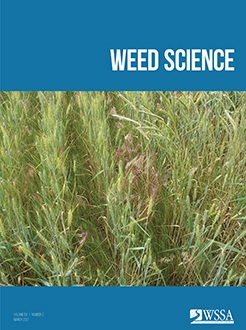Applying control measures when carbohydrate levels are low can decrease the likelihood of plant survival, but little is known about the carbohydrate cycles of dewberry (Rubus spp.), a problematic weed group on cranberry (Vaccinium macrocarpon Aiton) farms. Weedy Rubus plants were collected from areas adjacent to production beds on commercial cranberry farms in Massachusetts, two locations per year for 2 yr. For each site and year, four entire plants were collected at five phenological stages: budbreak, full leaf expansion, flowering, fruit maturity, and after onset of dormancy. Root sections were analyzed for total nonstructural carbohydrates (TNC; starch, sucrose, fructose, and glucose). Overall trends for all sites and years showed TNC were lowest at full leaf expansion or flowering; when sampled at dormancy, TNC concentrations were greater than or equal to those measured at budbreak. Starch, a carbohydrate form associated with long-term storage, had low levels at budbreak, leaf expansion, and/or flowering with a significant increase at fruit maturity and the onset of dormancy, ending at levels higher than those found at budbreak. The concentration of soluble sugars, carbohydrate forms readily usable by plants, was highest at budbreak compared with the other four phenological samplings. Overall, our findings supported the hypothesis that TNC levels within the roots of weedy Rubus plants can be predicted based on different phenological growth stages in Massachusetts. However, recommendations for timing management practices cannot be based on TNC cycles alone; other factors such as temporal proximity to dormancy may also impact Rubus plants recovery, and further research is warranted. Late-season damage should allow less time for plants to replenish carbohydrate reserves (before the onset of dormancy), thereby likely enhancing the effectiveness of weed management tactics over time. Future studies should consider tracking the relationship between environmental conditions, phenological stages, and carbohydrate trends.
How to translate text using browser tools
5 January 2021
Seasonal Nonstructural Carbohydrate Patterns in Dewberry (Rubus spp.) Roots
Katherine M. Ghantous,
Hilary A. Sandler
ACCESS THE FULL ARTICLE

Weed Science
Vol. 69 • No. 2
March 2021
Vol. 69 • No. 2
March 2021
Brambles
carbohydrate reserves
cranberry
integrated weed management
perennial weeds
woody weeds





